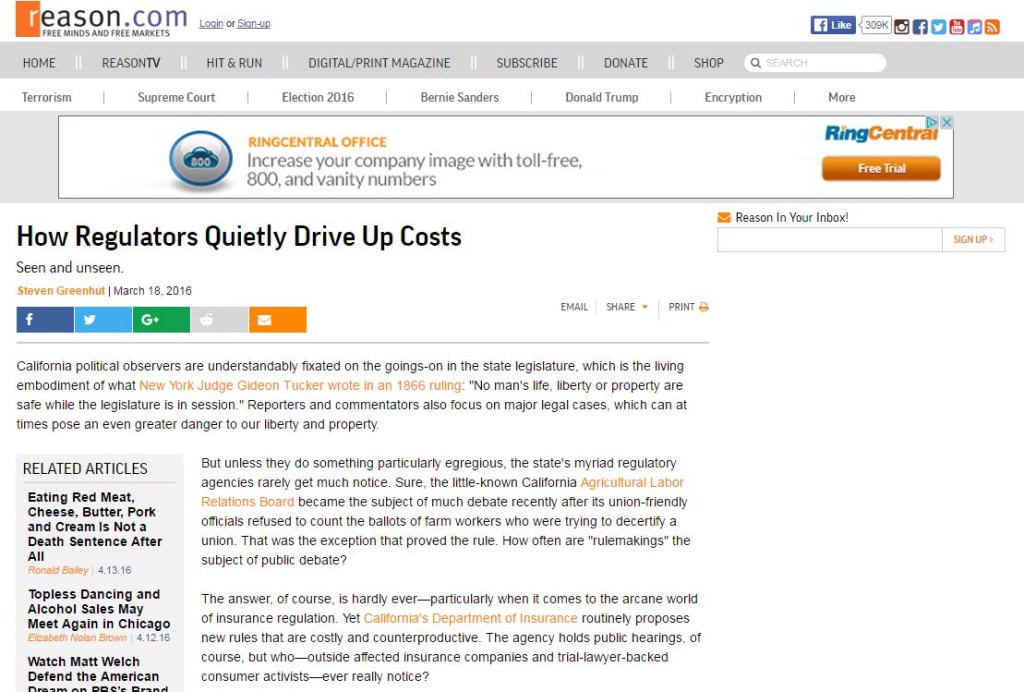
Reason R Street op-ed on proposed Calif. rate studies, steering rule misses the mark
By onBusiness Practices | Insurance | Legal | Market Trends | Repair Operations
A writer from the free-market R Street Institute last month attacked California’s proposed body shop-related insurance regulations as yet another example of Golden State government overreach.
Unfortunately, Steven Greenhut’s Reason op-ed is a knee-jerk “California regulation = bad” overreaction, with little to back up his arguments against those specific measures.
Let’s look at some of his points:
These labor-rate surveys are conducted by insurance companies to determine the standard costs for auto repairs in state-of-the-art facilities. Basically, the companies query body shops and determine the prevailing rate in each geographic region. They must provide those surveys to the insurance department. The first part of the new rule is of little consequence: It requires insurance companies to provide surveys in a consistent format that helps the department post them on its website.
Ironically, this transparency and consistency might be the biggest cause for insurer concern, based on the California Department of Insurance’s allegations of insurers trying to game the system.
More RDN coverage of California’s proposed labor rate, steering regulations
- Proposed Calif. DOI antisteering rules demand proof of ‘deceptive statements’, define ‘reasonable’ distances, time for non-DRP inspection
- California seeks to give insurers, repairers clear auto body labor rate survey rules
- Here’s what California says auto body labor rate surveys should look like
- California thinks an auto body labor rate market should be six shops. Here’s why.
- Absence of luxury repairers, 2005 ‘Class A’ definition could be concerns with Calif. labor rate effort
“Currently, the various insurers determine a geographic area in several ways, including but not limited to United States Postal Service (USPS) Zip Code areas, city, counties, multiple counties, and some highly irregular and customized ‘markets’ or ‘zones’ which the insurer creates,” the DOI wrote. “The Department’s experience is that some of the geographic areas used by insurers in surveys result in artificially inaccurate, unreliable, and unreasonably low labor rates that are not representative of the market. For example, in one instance, an insurer used its insurance adjusters’ territories as the geographic areas for its labor rate survey, which may have been convenient for the insurer, but which also had no relationship to the actual market areas where shops were located. The result is a significant range in labor rates used by insurers for the same insured, claimant, or repair shop. A claimant should not be paid significantly differently depending on which insurance company is paying the claim. In order to achieve greater consistency and reliability in the Standardized Labor Rate Survey, the Department finds it necessary to define geographic area.”
Back to Greenhut:
But we find the real significance deeper in the jargon-filled explanation: “The department received hundreds of complaints from consumers and auto body repair shops, alleging specific instances where consumers were forced to pay out-of-pocket costs, or shops were deprived of their reasonably charged rates due to outdated and unreliable surveys.” In other words, insurers pay claims based on those regional hourly rates. If a customer wants to use a costlier shop, that customer might have to pay the difference out of pocket.
Forget other words. Did he read the actual words “outdated and unreliable surveys?”
Essentially, the department is pushing insurers to follow its standards for determining labor rates, which will increase the hourly costs that insurers must pay. The department said the regulations will “prevent auto body repair shops from facing the dilemma of whether to accept a financial loss, or bill the consumer for the shortfall between the insurance payment and the estimate cost of repair.”
The revised (and original) survey proposed try to strike a balance between insurers and body shops in the messy three-agenda dance (insurance, customer, shop) that is at least 70 percent of the collision repair business.
It keeps insurers from using their influence to effectively set another business’ labor rates unilaterally. At the same time, it also avoids the concern that a body shop will try to charge insurance-paid work a gazillion dollars an hour by giving insurers the option to pay whatever is suggested by nearby shop out-of-pocket customer rates rather than the shop’s quoted or posted rate.
There’s another logical error here: What is Greenhut actually complaining about? By going through the column, we are told:
- Standardizing labor rate surveys is not cause for concern.
- Insurers should be able to use the regional rate determined by a survey to figure out what they’ll pay.
- Customers should pay anything beyond the rate determined by the survey.
That’s what will still happen. And insurers are still free to negotiate lower rates with direct repair program shops and recommend those shops to customers.
Such rules become more significant when one considers how automotive and casualty insurance rates are determined in California. Voters approved Proposition 103 in 1988, which not only froze those insurance rates, but created an elected insurance commissioner with the power to approve or reject rate increases. As a result, the Department of Insurance has more say than market forces in determining insurance rates. Insurers can’t simply raise or even lower rates without the department’s blessing.
That means that regulators are not just setting ground rules for the insurance industry. They are determining the actual prices that are charged and paid. So when new regulations are approved, they often drive up the cost of doing business and drive down profitability. It creates pressure for insurers to come back to the department and seek rate hikes, distorts the insurance market, leads to fewer consumer choices and erodes the state’s business climate. It crushes competition, which is the real way to drive down rates for insurance and everything else.
But what about competition within the collision repair industry based on quality, convenience, and service? Steering distorts that. So do flawed labor rate surveys. And it’s a double standard to say insurers should be allowed to set their own rates but body shops can’t.
Under the proposal, body shop rates in the study are pegged to the posted rate — the out-of-pocket competition amount. That’s the true body shop-customer free market.
Adopting this rule will, of course, drive up the cost of insurance-covered repairs. The department estimates an additional cost of $560,000 a year.
That’s not quite accurate. $560,000 is the amount the DOI thinks the regulation will deduct from the state of California’s $2 trillion-plus gross domestic product (0.000028 percent).
But we’ll help him make his own argument:
The state expects it’ll cost an insurer about $1.17 million the first year to both comply with the new rules and pay $1.15 million more to body shops. Some or all of that $20,000 administrative cost difference should fall in the years when insurers can adjust their findings by the California inflation rate rather than try a new study. (If deflation occurs, insurers can’t lower the rates.)
We agree the DOI doesn’t seem to consider the possibility insurers will pass some or all of those claims and survey expenses to policyholders. So let’s assume this happens and do the math:
California had about 23.8 million registered autos in 2014, according to the state DMV. About 14.7 percent of its motorists were uninsured in 2012, the last year we could find Insurance Information Institute data.
Assume the uninsured will still duck the law and the remaining 20.3 million owners all must share the $1.17 million cost. That’s less than 6 cents more per driver to remove the possibility that customer would have to eat those out-of-pocket costs on the back end.
The second proposed rulemaking comes under an equally banal-sounding headline: “Anti-steering in Auto Body Repairs.” Anti-steering provisions are meant to stop insurance companies from directing customers to use auto-body-repair shops the insurer prefers, rather than the customer’s own preference.
The new regulations, if approved, would require insurance companies to inspect a damaged vehicle within six business days. It would forbid them from requiring customers to travel more than 10 miles in urban areas and 25 miles in rural areas to have the vehicle inspected. It would limit any comments insurance companies could make about a particular auto-body repair shop as a means to dissuade customers from choosing that shop.
Such rules become more significant when one considers how automotive and casualty insurance rates are determined in California. Voters approved Proposition 103 in 1988, which not only froze those insurance rates, but created an elected insurance commissioner with the power to approve or reject rate increases. As a result, the Department of Insurance has more say than market forces in determining insurance rates. Insurers can’t simply raise or even lower rates without the department’s blessing.
Was there an actual complaint about the steering proposal? At best, Greenhut seems to hint at the possibility that an insurer couldn’t warn a customer about an actual bad shop.
However, considering that the proposal supports true market competition in terms of both preferred and non-preferred shops competing for the customer — not the insurer’s balance sheet — and grants personal responsibility and liberty to a customer to make their own decision, there might be more of a free market argument here than he thinks. Plus, the insurer can still blast a bad body shop so long as they have proof to back it up, and there’s another state agency (the BAR) charged with busting bad body shops as well.
Honestly, it seems like Greenhut’s more irritated about Proposition 103 than anything in the actual regulations, for he continues:
That means that regulators are not just setting ground rules for the insurance industry. They are determining the actual prices that are charged and paid. So when new regulations are approved, they often drive up the cost of doing business and drive down profitability. It creates pressure for insurers to come back to the department and seek rate hikes, distorts the insurance market, leads to fewer consumer choices and erodes the state’s business climate. It crushes competition, which is the real way to drive down rates for insurance and everything else.
California’s private passenger auto physical underwriting profit averaged 6.8 percent between 2005-2014, according to the National Association of Insurance Commissioners. Nationally, it was 5 percent. Insurers are doing better in the Golden State, despite the “People’s Republic of California’s” best efforts.
California does a lot of silly, business-killing regulation, but the auto body shop proposals so far don’t seem to be among them. The insurance-customer-service provider relationship is always going to be problematic, regardless of whether the service providers are doctors, contractors or body shops, and sometimes, some branch of government — be it the state or the court — is going to have to play referee.
As the R Street Institute itself acknowledges, “At the same time, we recognize that public goods, natural monopolies and externalities are real concerns that governments must sometimes address.”
More information:
“How Regulators Quietly Drive Up Costs”
Steven Greenhut op-ed in Reason, March 18, 2016
Auto body labor rate surveys: Initial statement of reasons
California Department of Insurance, March 4, 2016
Auto body labor rate surveys: Text of regulation
California Department of Insurance, March 4, 2016
Auto body labor rate surveys: Notice of proposed regulatory action
California Department of Insurance, March 4, 2016
Images:
Democratic California Insurance Commissioner Dave Jones speaks in 2012. (Provided by California Department of Insurance)
A writer from the free-market R Street Institute last month in Reason attacked California’s proposed body shop-related insurance regulations as yet another example of Golden State government overreach. (Screenshot from www.reason.com)

